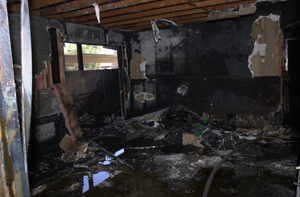At Risk At Home
Living Safely In Your Apartment
Because families in apartment complexes live so close together, there are special areas of concern when it comes to fire safety.
Apartment complexes are simply a series of small, connected homes. It’s important to remember that what you do in your apartment can affect people living six-doors down, or even in the next building.
- Apartment Hazards
- Apartment Living Safety Tips
- What To Do In Case of Fire
Tips for Living Safely in Apartment Buildings
Make sure you have smoke alarms that work.
The Fire Code requires working smoke alarm(s) in every apartment unit. Existing apartments require smoke alarms in the hallway outside sleeping areas. Newly constructed apartments now require them IN the sleep room, as well. Remember to check the batteries once a month, and replace the batteries once a year.
The apartment complex is required to have a fire extinguisher within 75-feet travel distance.
If extinguishers are not provided outside the apartments, then each apartment is required to have one.
The Fire Code states that no person shall use fixed or portable barbecues in or under any attached covered patios, balconies, covered walkways or roof overhangs.
When in use, barbecues should be located on ground level and be a minimum of 5-feet from buildings, structures, covered walkways or roof overhangs.
Don’t park in front of fire hydrants and don’t park in fire lanes.
Respecting the fire restrictions may literally save your life. When friends visit, be sure to remind them to park only in appropriate parking areas.
Never leave smoking materials burning. Never smoke in bed.
The most common cause of apartment fires was careless disposal of smoking materials.
Have a fire escape plan. Practice it.
Know at least two ways to get out of your apartment. Pick a family meeting place outside the apartment building. Don’t use elevators (they may take you right into the fire.)
Make sure there’s a number on your apartment door.
If there isn’t, contact management.
Keep a copy of your apartment number and apartment building number, inside your apartment, near the phone.
The information will then be handy for babysitters, and it will be there if you panic.
Complex owners and managers need to be sure gated driveways are accessible to firefighters.
75-percent of multi-housing complexes are now gated. Work with the fire department to make sure access requirements are met.
Don’t run extension cords under carpets or from unit-to-unit.
They can easily overheat. Extension cords are for temporary use only. They are not to be used as a substitute for permanent wiring.
Get acquainted with the elderly folks in your building.
If there’s a fire, they may have extra difficulty getting out. You may be able to help them, or you can direct firefighters to the elderly person’s apartment.
Special hazards that affect people who live in apartments:
- Often, there is only one way in or out—no back door.

- Stairways are often built entirely of wood. If the stairwell or walkway is on fire, you may not be able to exit through the front door.
- Congested parking can mean blocked fire hydrants and/or blocked fire lanes. (A ladder truck can be 8 to 9-feet wide and 50-feet long. A blocked fire lane can slow down response time.)
- An apartment building is, in effect, a very densely populated neighborhood. (If the downstairs or next-door apartment is on fire, it can spread quickly to adjoining apartments in a matter of minutes.)
- Without properly working smoke alarms, it make take a long time before you find out that another part of the apartment building is on fire. Consequently, this could cut your chances of getting out of the building alive.
